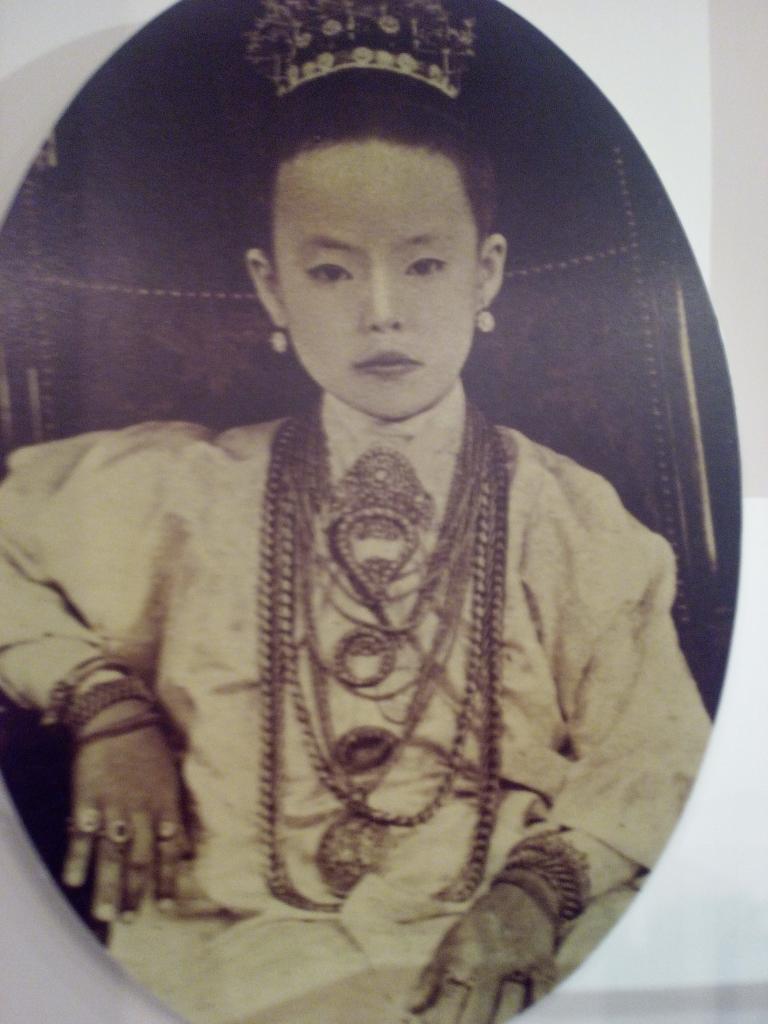私はマラッカの華人女性達が宝飾品にかけた思いと、その子孫たちの今を思った。彼女たちが、はるばると遠い中国の職人へ発注したり、遠い場所から品物をマラッカへ海運してまで、それらを求めた理由は、なんなのだろう。
昔バンクーバーに居たときに、どっしりとした五段重ねの尾篭度を張った食器ケースや、切るときにいつも力が入るあたりが摩減した銀製のナイフを、大事に使っていた友人がいた。夫と二人で中国からカナダへ移住したが、カナダで夫と離婚し、離婚後の一時期落ち込んでいたその友人は、カナダから中国のずっと占めてあった家に戻って古い銀器を手に入れ、それらを荷造りして海運し、バンクーバーで銀器の包装を開いたとき、思ったという。これがあれば、どんな場所にいても、もういちど、やりなおせる。
マラッカの初期の移住者の女性達にとっては、使い慣れた食器や装飾品を異国でも手に入れたとき、彼女たちにも勇気がわいて、これがあれば、遠い異郷にいても暮らせるという深い安心と一緒に、定住へ向けての気持ちがより固まったのではなかっただろうか。そしてそのような役割を果たしたからこそ、それらの品々は代々大切にされてきたのではないだろうか。最も、それら品々が純粋に美しい、と言うのも、大切にされた一つの理由ではあるだろうけれど。
波が貝殻を残してゆくように、女性はかたみを残し、生きたしるしを置いてゆく。真珠や首飾り、繊細に刺繍した靴、かんざしや櫛。それらの品々は、博物館の片隅だけでなく、今遠い国々で、家々のたんすの奥に、ひっそりと息づいているのかもしれない。遠いいのちをひきついだ、新たな旅立ちを迎えた子どもたちのもとで。シンガポールやマレーシアに、今風のビジネススーツに身を包みダウンタウンを歩きながらも、数百年前に中国で特製した母や祖母の名残の品を、身のどこかに一つだけ飾った女性たちがいるのかもしれない。彼女たちは、それらを身にまとって祖母たちを思い、日々の暮らしの中で、ふと心華やいだりするのだろうか。
過ぎ去った時代の面影の品々にかこまれて見た、微笑みをたたえた女性の写真には、マラッカに特徴的な淡いパステル色の小鳥が描かれた銀色の首飾りが、小さな宝石のように輝いていた。
徘徊在展品前,佩戴着首饰的女子及她的后代现在过得怎样呢,我不禁遐想起来。像被波浪卷起而留在沙滩上的贝壳一样,女性们留下她们生活印记离去了。珍珠镶嵌的首饰、精致的绣花鞋、头梳等等,不仅能在博物馆的一角里看到,在某些遥远的地方,同类的东西或许正静静地躺在家里的衣箱里,这些子孙们在遥远他乡又要开始新的旅程吧。无论在新加坡,还是马来西亚,如今也会有现代的女性在时尚的服装上面点缀一件母亲或祖母留下的饰物。带着这样的饰物,身在在遥远的天空下,心里一定快乐安详吧。
观赏着笼罩在一个世纪前的气氛下的照片中微笑着的女子,银首饰上用具有马六甲着色淡雅特征的风格描绘的鸟儿像宝石一样闪烁着特有的光芒。
When I was living in Canada, I had a friend who had immigrated to Vancouver with her husband as a couple. While in Vancouver, their marriage fell apart due to the stress of immigration and of living in a foreign country. After the divorce, living alone in a new country, she had needed emotional support to sustain her new life, but it was nowhere to be found in her new home in Vancouver. She visited her old home in China, packed a set of old dinnerware inherited from her parents, and shipped them to Vancouver. When she opened her box containing the silverware in Vancouver in the exact same condition as when she had used them in her daily life in China, for the first time she felt comforted by the presence of something familiar; and felt that she could go on living in Vancouver.
For the women in Malacca who have first migrated to Malacca, the jewellery and the dinnerware from China may have served a similar purpose as my friend’s dinnerware – it was a piece of home, offering them comfort in the new land, and thus valuable. Of course, the fact that the jewellery had value as exquitely crafted pieces of art, apart from their sentimental value, contributed to their worth as well.
The jewellery worn by the Malaccan women had remained in the city long after the women themselves were gone. Some of their jewellery, the ones that aren’t on display in the museums, may be stored inside homes of these women’s children, lying in a cabinet drawer in Singapore or elsewhere in Malaysia. There may be women walking down the Central Business District, dressed in a tailored, modern business suit, with a piece of her grandmother’s necklace, imported from China and carried from Malacca, discreetly shining. Perhaps they may, at time, remember their grandmothers who owned the jewellery before them, and be glad of the thread of familial and historical connection the jewellery represents.
